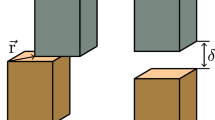Abstract
High entropy alloys (HEAs) are composed of equal or nearly equal quantities of five or more metals that solidify into a single, or sometimes dual, solid solution phase. Due to improved properties in high-temperature and high-stress applications, HEAs have the potential to replace traditional alloy systems in future engineering applications, such as turbine blades and thermal spray coatings. In the present work, first-principle calculations based on density functional theory are used to calculate and rank the stacking fault energies of several quinary HEA systems in order to better understand the slip and deformation behavior of HEA systems. Special quasirandom structures are used to represent the single solid solution with a finite number of atoms and calculations are performed in the Vienna ab initio simulation package within the generalized gradient approximation as implemented by Perdew, Burke, and Ernzerhof. Stacking fault energy calculations are based on the difference between the ground state energy of the perfect HEA structure and the ground state energy of a faulted HEA structure. To validate the calculations, results are compared to experimental data, such as lattice parameter and formation energy, for well-studied HEA system.
Access this chapter
Tax calculation will be finalised at checkout
Purchases are for personal use only
Similar content being viewed by others
References
Gao MC, Yeh J-W, Liaw PK, Zhang Y (2016) High-entropy alloys: fundamentals and applications. Springer
Reed R (2008) The superalloys: fundamentals and applications. Cambridge University Press, Cambridge
Machado LG, Savi MA (2003) Medical applications of shape memory alloys. Braz J Med Biol Res 36(6):683–691
Abbaschian R, Reed-Hill RE (2008) Physical metallurgy principles. Cengage Learning
Guo Z, Miodownik AP, Saunders N, Schille JP (2006) Influence of stacking-fault energy on high temperature creep of alpha titanium alloys. Scr Mater 54(12):2175–2178
Mclean D (1962) Deformation at high temperatures. Metall Rev 7(1):481–527
Weertman J (1965) Theory of the influence of stacking-fault width of split dislocations on high-temperature creep rate. Trans Metall Soc AIME 233:2069–2074
Barrett CR, Sherby OD (1965) Influence of stacking-fault energy on high-temperature creep of pure metals. Trans Metall Soc AIME 223:1116
Zaddach AJ, Niu C, Koch CC, Irving DL (2013) Mechanical properties and stacking fault energies of NiFeCrCoMn high-entropy alloy. JOM 65(12):1780–1789
Zhang YH, Zhuang Y, Hu A, Kai JJ, Liu CT (2017) The origin of negative stacking fault energies and nano-twin formation in face-centered cubic high entropy alloys. Scr Mater 130:96–99
Zunger A, Wei SH, Ferreira LG, Bernard JE (1990) Special quasirandom structures. Phys Rev Lett 65(3):353–356
Zacherl C, Saal J, Wang Y, Liu ZK (2010) First-principles calculations and thermodynamic modeling of the Re-Y system with extension to the Ni-Re-Y system. Intermetallics 18(12):2412–2418
Shin D, van de Walle A, Wang Y, Liu Z-K (2007) First-principles study of ternary fcc solution phases from special quasirandom structures. Phys Rev B 76(14):144204
Kresse G, Furthmuller J (1996) Efficient iterative schemes for ab initio total-energy calculations using a plane-wave basis set. Phys Rev B 54(16):11169–11186
Blöchl PE (1994) Projector augmented-wave method. Phys Rev B 50(24):17953
Perdew JP, Burke K, Ernzerhof M (1996) Generalized gradient approximation made simple. Phys Rev Lett 77(18):3865
Methfessel M, Paxton AT (1989) High-precision sampling for Brillouin-zone integration in metals. Phys Rev B 40(6):3616
Blochl PE, Jepsen O, Andersen OK (1994) Improved tetrahedron method for Brillouin-zone integrations. Phys Rev B 49(23):16223
Acknowledgements
Calculations performed in this work used the Extreme Science and Engineering Discovery Environment (XSEDE), which is supported by National Science Foundation grant number ACI-1053575, on grant award RF-DMR160006. Start-up funding from New Mexico Institute of Mining and Technology and a generous gift from an anonymous donor were also used to perform this research. The authors would like to thanks J. E. Saal for stimulating discussions related to the research.
Author information
Authors and Affiliations
Corresponding author
Editor information
Editors and Affiliations
Rights and permissions
Copyright information
© 2018 The Minerals, Metals & Materials Society
About this paper
Cite this paper
Scheer, A.M., Strother, J.D., Hargather, C.Z. (2018). First-Principles Calculations of Stacking Fault Energies in Quinary High-Entropy Alloy Systems. In: & Materials Society, T. (eds) TMS 2018 147th Annual Meeting & Exhibition Supplemental Proceedings. TMS 2018. The Minerals, Metals & Materials Series. Springer, Cham. https://doi.org/10.1007/978-3-319-72526-0_62
Download citation
DOI: https://doi.org/10.1007/978-3-319-72526-0_62
Published:
Publisher Name: Springer, Cham
Print ISBN: 978-3-319-72525-3
Online ISBN: 978-3-319-72526-0
eBook Packages: Chemistry and Materials ScienceChemistry and Material Science (R0)




